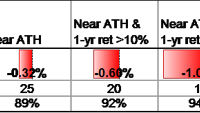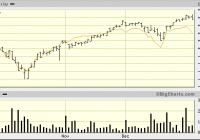By David Objective and strategy The fund pursues long-term capital appreciation by investing in large cap growth stocks, which it defines generously as those with capitalizations over $5 billion. The manager describes his style as having a “value orientation toward growth.” Their discipline combines a macro-level sensitivity to the effects of powerful and enduring secular changes and on industries which are being disrupted, with intense fundamental research and considerable patience. The fund holds a fair fraction of its portfolio, about 20% at the end of 2014, in mid-cap stocks and has a small lower market cap, lower turnover and more compact portfolio than its peers. Most portfolio positions are weighted at about 2-3% of assets. Adviser RiverPark Advisors, LLC. RiverPark was formed in 2009 by former executives of Baron Asset Management. The firm is privately owned, with 84% of the company being owned by its employees. They advise, directly or through the selection of sub-advisers, the seven RiverPark funds. Overall assets under management at the RiverPark funds were over $3.5 billion as of September, 2014. Manager Mitch Rubin, a Managing Partner at RiverPark and their CIO. Mr. Rubin came to investing after graduating from Harvard Law and working in the mergers and acquisitions department of a law firm and then the research department of an investment bank. The global perspective taken by the M&A people led to a fascination with investing and, eventually, the opportunity to manage several strategies at Baron Capital. He’s assisted by RiverPark’s CEO, Morty Schaja, and Conrad van Tienhoven, a long-time associate of his. Mitch and his wife are cofounders of The IDEAL School of Manhattan, a small school where gifted kids and those with special needs study and play side-by-side. Strategy capacity and closure While Morty Schaja describes capacity and closure plans as “somewhat a comical issue” for a tiny fund, he estimates capacity “to be around $20 billion, subject to refinement if and when we get in the vicinity.” We’ll keep a good thought. Active share 79.6, as of November 2014. “Active share” measures the degree to which a fund’s portfolio differs from the holdings of its benchmark portfolio. High active share indicates management which is providing a portfolio that is substantially different from, and independent of, the index. An active share of zero indicates perfect overlap with the index, 100 indicates perfect independence. As a rule of thumb, large cap funds with an active share over 70 have legitimately “active” managers while the median for Morningstar’s large cap Gold funds is 76. The active share for RiverPark Large Growth is 79.6, which reflects a high level of independence from its benchmark, the S&P 500 index. Management’s stake in the fund Mr. Rubin and Mr. Schaja each have over $1 million invested in the fund. Between them, they own 70% of the fund’s institutional shares. One of the fund’s three trustees has invested between $10,000 and $50,000 in the fund while the other two have not invested in it. As of December 31, 2013, the Trustees and officers of the Trust, as a group, owned 16.27% of the outstanding shares of the fund. We’d also like to compliment RiverPark for exemplary disclosure: the SEC allows funds to use “over $100,000” as the highest report for trustee ownership. RiverPark instead reports three higher bands: $100,000-500,000, $500,000-1 million, over $1 million. That’s really much more informative than the norm. Opening date September 30, 2010. Minimum investment The minimum initial investment in the retail class is $1,000 and in the institutional class is $100,000. Expense ratio Retail class at 1.25% after waivers, institutional class at 1.00% after waivers, on total assets of $69 million. Comments If we had written this profile in January 2014 instead of January 2015, our text could have been short and uncontroversial. It would read something like: Mitch Rubin is one of the country’s most experienced growth managers. He’s famously able to follow companies for decades, placing them first in one of the small cap funds he has run, later in a large cap fund before selling them when they plateau and shorting them as they enter their latter years. With considerable discipline and no emotional investment in any of his holdings, he has achieved outstanding results here and in his earlier charges. From inception through the end of 2013, Large Growth has dramatically outperformed both its large cap growth peer group and the S&P 500, and had easily matched or beaten the performance of the top tier of growth funds. That includes Sequoia (MUTF: SEQUX ), RiverPark/Wedgewood (MUTF: RWGFX ), Vanguard PrimeCap (MUTF: VPMCX ) and the other Primecap funds. Accurate, true and sort of dull. Fortunately, 2014 gave us a chance to better understand the fund and Mr. Rubin’s discipline. How so? Put bluntly, the fund’s short-term performance sort of reeked and it managed to reduce a five-star rating down to a three-star one. While it finished 2014 with a modest profit, the fund trailed more than 90% of its large-growth peers. That one year slide then pulled its three-year record from “top 10%” to “just above average.” The question is: does 2014 represent “early” (as in, the fund moved toward great companies whose discount to fair value kept growing during the year) or “wrong” (that is, making an uninformed, undisciplined or impulsive shift that blew up)? If it’s the former, then 2014’s lag offers reasons to buy the fund while its portfolio is underpriced. If it’s the latter, then it’s time for investors to move on. Here’s the case that Mitch, Conrad and Morty make for the former. They’re attempting to invest in companies which will grow by at least 20% a year in the future, in hopes of investing in stocks which will return 20% a year for the period we hold them. Since no company can achieve that rate of growth, the key is finding growth that is substantially underpriced. There’s a sort of time arbitrage at work, a claim that’s largely substantiated by a lot of behavioral finance research. Investors generally do not give companies credit for high rates of growth until that growth has been going on for years, at which point they pile in. RiverPark’s goal is to anticipate where next year’s growth is going to be, rather than buying where last year’s growth – or even this year’s growth – was. The proper questions then are (1) is the company’s performance outpacing its stock performance? And, if so, (2) can that performance be sustained? If you answer “yes” to both, then it’s probably time to buy. The mantra was “buy, hold, and, if necessary, double down.” If they’re right, in 2014 they bought a bunch of severely underpriced growth. The firms in the portfolio are growing earnings by about 20% a year and they’re paying a 16x p/e for those stocks. Investors in the large cap universe in general are also paying a 16x p/e, but they’re doing it for stocks that are growing by no more than 7% annually. Those lower quality firms have risen rapidly, bolstered by low interest rates which have made it cheap for them to buy their way to visibility through financial engineering; debt refinance, for example, might give a one-time boost to shaky earnings while cheap borrowing encourages them to “buy growth” by acquiring smaller firms. Such financial engineering, though, doesn’t provide a basis for long-term growth. For the Large Growth portfolio, they target firms with “fortress-like balance sheets.” So, they buy great growth companies for cheap. How does that explain the sudden sag in 2014? They point to three factors: Persistently low interest rates : in the short term, they prop up the fortunes of shaking companies, whose stock prices continue to rise as late-arriving investors pile in. In the interim, those rates punish cash-rich financial services firms like Schwab (SCH) and The Blackstone Group (NYSE: BX ). Energy repricing : about 13% of the portfolio is focused on energy firms, about twice the category average. Three of their four energy stocks have lost money this year, but are cash-rich with a strong presence in the Marcellus shale region. Globally natural gas sells for 3-4 times more than it does in the US; our prices are suppressed by a lack of transport capacity. As that becomes available, our prices are likely to move toward the global average – and the global average is likely to rise as growth resumes. Anti-corruption contagion : the fund has a lot of exposure to gaming stocks and gaming companies have a lot of exposure to Asian gambling and retail hubs such as Macau. Those are apt to be incredibly profitable long-term investments. The Chinese government has committed to $500 billion in new infrastructure investments to help middle class Chinese reach Macau, and Chinese culture puts great stock in one’s willingness to challenge luck. As a result, Chinese gamblers place far higher wagers than do Western ones, casinos catering to Chinese gamblers have far higher margins (around 50%) than do others and the high-end retailers placed around those casinos rake in about $7,000 per square foot, well more than twice what high-end stores here make. In the short term, though, Prime Minister Xi’s anti-corruption campaign has terrified Chinese high-rollers who are buying and gambling a lot less in hopes of avoiding the attention of crusaders at home. While the long-term profits are driven by the mass market, in the short term their fate is tied to the cowed high-wealth cohort. Sooner rather than later, the managers argue, energy prices will rise and firms like Cabot Oil & Gas (NYSE: COG ) will see their stocks soar. Sooner rather than later, the gates of Macau will be opened to hundreds of millions of Chinese vacationers, anxious to challenge luck and buy some bling and stocks like Wynn Resorts (NASDAQ: WYNN ) will rise dramatically. This is not a high turnover, momentum strategy designed to capture every market move. Almost all of the apparent portfolio turnover is simply rebalancing within the existing names in order to capture a better risk/return profile. It’s a fairly patient strategy that has, for decades, been willing to tolerate short-term underperformance as the price of long-term outperformance. Bottom Line The argument for RiverPark is “that spring is getting compressed tighter and tighter.” That is, a manager with a good track record for identifying great underpriced growth companies and then waiting patiently currently believes he has a bunch of very high quality, very undervalued names in the portfolio. They point to the fact that, for 26 of the 39 firms in the portfolio, the firm’s underlying fundamentals exceeded the market while the stock price in 2014 trailed it. It is clear that the manager is patient enough to endure a flat year or two as the price for long-term success; the fund has, after all, returned an average of 20% a year. The question is, are you? Fund website RiverPark Large Growth . Folks interested in hearing directly from Messrs. Rubin and Schaja might listen to our December 2014 conference call with them, which is housed on the Featured Fund page for RiverPark Large Growth.

